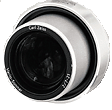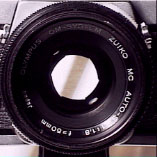The Digital Future - A Guide to Digital Camera Reviewing
by Matthew Witheiler on October 6, 2000 3:32 AM EST- Posted in
- Guides
The Lens
 Perhaps
one of the most crucial aspects to the digital camera is the lens. Although
digital cameras share little in common with their 35mm counterparts, the lens
of a camera remains virtually unchanged. In fact, the lens of a camera can make
or break a digital camera's ability to produce realistic pictures. Let's go
over some of the key aspects of the digital camera lens.
Perhaps
one of the most crucial aspects to the digital camera is the lens. Although
digital cameras share little in common with their 35mm counterparts, the lens
of a camera remains virtually unchanged. In fact, the lens of a camera can make
or break a digital camera's ability to produce realistic pictures. Let's go
over some of the key aspects of the digital camera lens.
The lens performs the action of taking the external world and focusing it down to square the size of the camera's imaging sensor, which then records the image. There are quite a wide variety of lenses out there but all perform this fundamental action.
In addition to focusing down the image, the lens also determines how much light can get through to the imaging sensor. This setting is called aperture and is measured on cameras in f-stops. The f-stop of a lens determines how much light the camera can let through to the image sensor, with smaller f-stops resulting in a larger opening for light (aperture and f-stops are inversely related, meaning that a large f-stop equates to a small aperture). This opening is made from inside the lens via a set of overlapping "leafs" of sorts that act in a similar manner to the pupil of an eye.
 In
cameras, the aperture setting of the lens and the shutter speed of the camera
are closely related. This is because with a larger aperture (smaller f-stop)
the camera must use a faster shutter speed to expose the image properly. The
inverse is also true: a smaller aperture (larger f-stop setting) means that
the camera must use a slower shutter speed to let the proper amount of light
through. For a parallel, think of the human eye. Looking at a bright light while
one's pupil is dilated (related to a large aperture, small f-stop) causes one's
pupil to quickly contract when placed in a bright light situation to prevent
an image from looking too bright. The opposite happens with a contracted pupil
placed in dark light, which quickly dilates to make the image visible.
In
cameras, the aperture setting of the lens and the shutter speed of the camera
are closely related. This is because with a larger aperture (smaller f-stop)
the camera must use a faster shutter speed to expose the image properly. The
inverse is also true: a smaller aperture (larger f-stop setting) means that
the camera must use a slower shutter speed to let the proper amount of light
through. For a parallel, think of the human eye. Looking at a bright light while
one's pupil is dilated (related to a large aperture, small f-stop) causes one's
pupil to quickly contract when placed in a bright light situation to prevent
an image from looking too bright. The opposite happens with a contracted pupil
placed in dark light, which quickly dilates to make the image visible.
Typically, the more f-stop settings a lens has the better the lens. While a lens with many f-stop settings is harder to produce, it allows for more flexibility when picture taking. For example, in very low light situations, it is necessary to have a lens that has a very small f-stop setting so that the shutter speed can be adequate for the low level of light. Using a large f-stop in such a situation would require a very slow shutter speed, an undesirable situation when one is holding the camera in hand. Higher f-stop settings are good for bright situations where extremely fast shutter speeds are needed to produce the proper exposure.
For the most part, digital camera lenses fall far behind SLR (single lens reflex) 35mm cameras when it comes to f-stop settings. Generally, these lenses have many more f-stop settings allowing for picture taking in nearly every situation.
There are other aspects that aperture plays in picture taking. More advanced users may wish to adjust the f-stop setting of the camera to change the picture's depth of field, a term which describes how much of the picture's background is in focus. Generally, it can be thought that a larger f-stop (smaller aperture) produces both background and foreground in focus while a smaller f-stop (larger aperture) produces pictures where only the subject is in focus. We will elaborate on these terms in future reviews, but for now the general drift can be had.
In addition to f-stop settings, many digital camera lenses include a zoom feature. There are two types of zooms found on digital cameras: optical zoom and digital zoom. Optical zoom is just as it sounds, increasing or decreasing the image size by changing the position of the lens via an internal motor. In this type of case, the camera lens will typically extend itself form the camera body to alter the distance between the lens and the imaging sensor. Digital zoom is a feature not found on 35mm cameras. What digital zoom does is reproduce a zoom effect by essentially increasing the size of the image that the camera sees. Think of this as taking a smaller picture in an image editor and resizing it to a larger size.
Anyone who has performed such an action on an image knows that there are many undesired effects of digital zooming. Essentially, digital zoom increases the amount of graininess and fuzziness seen in the image. The digital zoom found in many digital cameras still have these problems, however many manufacturers includes an image enhancing algorithm to reduce the appearance of these artifacts. Unfortunately there is no question that the quality of a digital zoomed picture is far less clear than that of an optically zoomed picture.
In addition to the amount a lens can optically zoom, the speed at which it does so is also very important. When one wants to zoom in on that perfect shoot, speed is crucial. The slower the lens reacts to zooming in and out optically, the less ideal it is.
Finally, the type and quality of glass used in the lens elements is very important to final image quality. Poor quality glass can have a large effect on the clarity and color trueness of the resulting image.
One way to test how good the lens is at resolving images is to use an IEEE approved resolution chart. This chart contains a series of fine lines that come very close together. The quality of the lens is very dependent on how the camera distinguishes the lines between one another until it becomes just one solid line. Look for more on how to read this chart in future camera reviews.











0 Comments
View All Comments